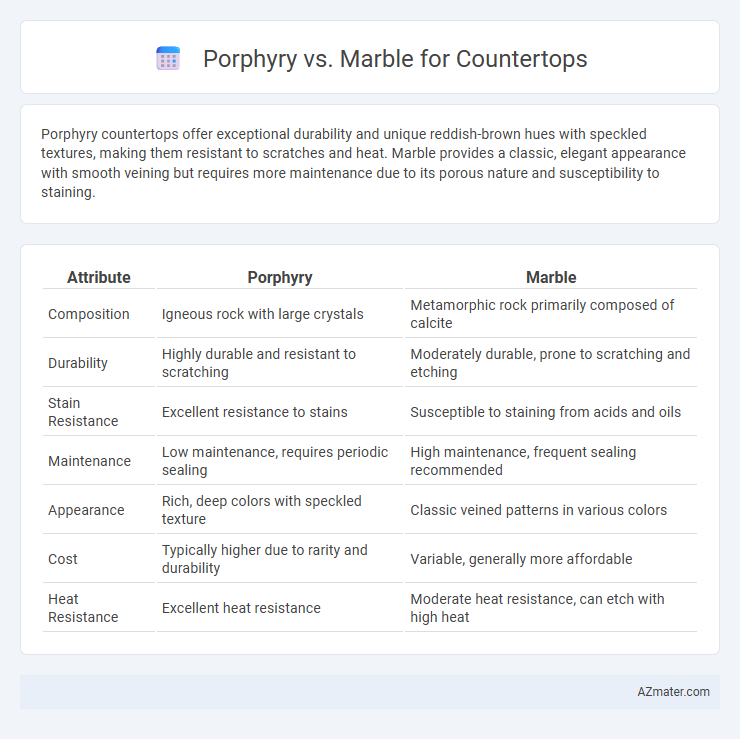Porphyry countertops offer exceptional durability and unique reddish-brown hues with speckled textures, making them resistant to scratches and heat. Marble provides a classic, elegant appearance with smooth veining but requires more maintenance due to its porous nature and susceptibility to staining.
Table of Comparison
| Attribute | Porphyry | Marble |
|---|---|---|
| Composition | Igneous rock with large crystals | Metamorphic rock primarily composed of calcite |
| Durability | Highly durable and resistant to scratching | Moderately durable, prone to scratching and etching |
| Stain Resistance | Excellent resistance to stains | Susceptible to staining from acids and oils |
| Maintenance | Low maintenance, requires periodic sealing | High maintenance, frequent sealing recommended |
| Appearance | Rich, deep colors with speckled texture | Classic veined patterns in various colors |
| Cost | Typically higher due to rarity and durability | Variable, generally more affordable |
| Heat Resistance | Excellent heat resistance | Moderate heat resistance, can etch with high heat |
Introduction to Porphyry and Marble Countertops
Porphyry countertops are valued for their durability, distinctive granular texture, and deep reddish-purple hues, making them a unique choice for high-end kitchens. Marble countertops offer timeless elegance with their smooth surface, wide range of color variations, and natural veining, popular in both traditional and modern designs. Both materials provide strong aesthetic appeal, but porphyry is more resistant to scratching and heat, while marble requires more maintenance to prevent staining.
Geological Origins: Porphyry vs Marble
Porphyry originates from volcanic igneous processes, characterized by large crystals embedded in a fine-grained matrix, showcasing a durable and dense structure ideal for countertops. Marble forms through the metamorphism of limestone, exhibiting a crystalline texture with distinctive veining created by mineral impurities during recrystallization. The geological origins of porphyry result in higher hardness and resistance compared to the softer, more porous marble, influencing their suitability for different countertop applications.
Appearance and Color Variations
Porphyry countertops exhibit a unique, coarse-grained texture with reddish-brown hues and distinctive large mineral crystals, creating a bold, earthy aesthetic. Marble offers a classic, elegant appearance characterized by smooth surfaces and a wide spectrum of color variations, including white, gray, green, and pink, with natural veining patterns that enhance its luxurious appeal. The color stability of porphyry contrasts with marble's susceptibility to subtle shifts in tone and veining, giving each material a distinctly different visual impact for countertops.
Durability and Strength Comparison
Porphyry countertops exhibit exceptional durability due to their igneous origin, featuring a dense crystalline structure that resists scratches, heat, and heavy impacts better than marble. Marble, while prized for its elegant veining, is more prone to etching and chipping because of its softer, calcite-based composition. In terms of strength, porphyry outperforms marble with higher compressive strength and superior resistance to wear, making it ideal for high-traffic kitchen surfaces.
Porosity and Stain Resistance
Porphyry countertops offer significantly lower porosity compared to marble, making them more resistant to moisture absorption and staining. The dense structure of porphyry minimizes the penetration of liquids, enhancing its durability in kitchen environments prone to spills. In contrast, marble's higher porosity increases vulnerability to stains and requires regular sealing to maintain its appearance.
Maintenance and Upkeep Requirements
Porphyry countertops require minimal maintenance due to their high hardness and natural resistance to scratches and stains, making them ideal for busy kitchens. Marble, while visually stunning with its classic veining, demands regular sealing and more careful upkeep to prevent etching, staining, and damage from acidic substances. Porphyry's durability significantly reduces cleaning frequency, whereas marble requires gentle cleaning with pH-neutral products to maintain its polished surface.
Cost Differences: Porphyry vs Marble
Porphyry countertops typically cost between $70 and $120 per square foot, making them more expensive than common marble options, which range from $40 to $100 per square foot depending on quality and origin. The higher price of porphyry reflects its durability, rarity, and unique aesthetic featuring deep red or purple hues with granular textures. Marble offers a classic, elegant look at a comparatively lower price but may incur additional maintenance costs due to its susceptibility to scratching and staining.
Environmental Impact and Sustainability
Porphyry countertops offer a more sustainable choice due to their natural durability and minimal need for chemical treatments compared to marble, which often requires intensive quarrying and polishing processes that consume more energy. Porphyry's resistance to scratches and acids reduces the frequency of replacements, leading to lower long-term environmental impact. Marble extraction contributes significantly to habitat disruption and carbon emissions, making porphyry a greener option for eco-conscious homeowners.
Design Flexibility and Application
Porphyry offers exceptional design flexibility due to its unique texture and color variations, making it ideal for bold, contemporary countertops. Marble provides classic elegance with smooth veining patterns but is more limited in application because of its susceptibility to scratching and staining. Both materials can be tailored to different aesthetics, but porphyry's durability allows for more versatile uses in high-traffic kitchen environments.
Choosing the Right Stone for Your Countertop
Porphyry offers exceptional durability and resistance to heat and scratches, making it ideal for high-traffic kitchen countertops, while marble provides a timeless elegance with its unique veining but requires more maintenance due to its susceptibility to staining and etching. Porphyry's dense, coarse-grained structure ensures long-lasting performance and minimal upkeep, whereas marble's softer calcite composition demands regular sealing to preserve its polished appearance. Selecting between porphyry and marble depends on balancing the need for durability with aesthetic preferences and maintenance commitment for your countertop surfaces.

Infographic: Porphyry vs Marble for Countertop
 azmater.com
azmater.com